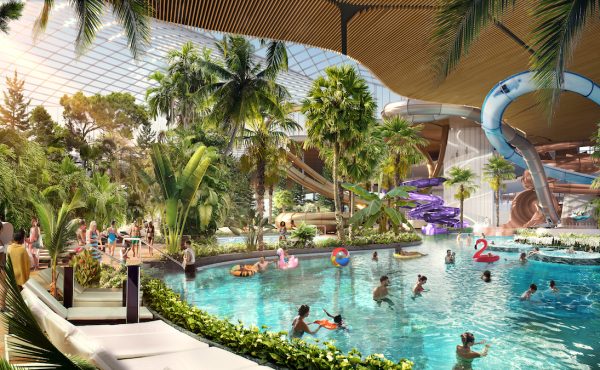 Today’s development story is not about the waterfront. Its about “downtown” Vaughan. It seems developers like the idea of the Spadina subway line coming north of Steeles, to help build a dense “downtown” area around Jane and Highway 7 (currently it is a nondescript light industrial area).
Today’s development story is not about the waterfront. Its about “downtown” Vaughan. It seems developers like the idea of the Spadina subway line coming north of Steeles, to help build a dense “downtown” area around Jane and Highway 7 (currently it is a nondescript light industrial area).
The dream of Vaughan building its own downtown from scratch has taken on a new sense of importance with the province’s decision to extend the TTC subway system into the so-called city above Toronto. For about eight years, planners and politicians in Vaughan have been putting together a proposal for a 600-acre development called the Vaughan Corporate Centre from roughly Highway 407 north to Highway 7, with the centrepiece being a 125-acre downtown.
“Without the subway I don’t think the dream can be realized … the subway will make it happen,” said Vaughan Mayor Michael Di Biase, noting that developers are already eagerly lining up.
This sounds great and I hope it happens. But I am worried that it will end up looking like “downtown” North York (see below). That area is dense, with over 20 condo towers (avg. 25 floors) between Sheppard and Finch, but also extremely sterile and handles six lanes of slow-moving traffic. If a development project ever needed a design review panel (like the City of Toronto is testing in four developing neighbourhoods), Downtown Vaughan should be near the top of the list.





10 comments
How is it any more sterile than King & Bay, which is a bunch of towers, with a few street level shops, slow-moving traffic, no people on the weekend and meticulous sidewalks? Or what Yonge & Dundas is to be? What the heck is sterile supposed to connote anyway?
A design panel absolutely. North York Centre is interesting because they did some things so right. The development is aligned to a “real” street rather than to artificially meandering streets in a loop like many other suburban downtowns, the area is served by three subway stops, the developments are very dense, there is a great library, a performing arts space, a civic square, a mix of offices and retail. Yet none of it holds together, and it’s quite an unpleasant area to move around in. I think a design review panel that enforces associations between buildings would help, but I’m not optimistic about the chances for a livable “downtown” in Vaughan.
I just bought a condo in the area and I love it. I used to live downtown, and find the area has all the same elements (bustling lifestyle, lots of restaurants, places open late, etc.) without alot of the hassle. What’s more, if I move just a block east or west, I’m in a suburb packed with parks.
What hassle?
Vaughan will never have a design review panel. And the downtown development will languish for many years to come, and perhaps never happen.
The reason is simple: noone is watching.
Media do not cover Vaughan city council. Its decisions are scrutinized by noone. Almost total impunity reigns. And there are no local media to cover it — the so-called “community newspapers”, a network of advertising vehicles all run centrally from a single office somewhere, are not interested in journalism.
I think it’s great that Spacing is noticing. But let’s be serious: the subway announcement is Vaughan’s fifteen minutes of fame and, in a month or two, the existence of a city council which makes decisions will once again be totally forgotten. And they will go on behind closed doors as before. And car-oriented two-storey residential tract suburbs which sprawl on for acres without a commercial base will continue to happen.
Media do a pretty weak job of covering Toronto City Council too. I don’t think media “scrutiny” is getting Toronto anywhere. Vaughan’s level of local democracy is miles above Toronto’s. In Vaughan they have a Committee of the Whole, which is where you can actually depute your entire city council, instead of having to make four separate appearances simultaneously. It goes without exception in Ontario: the smaller the city, the stronger the democracy.
I beg to differ about “sterile” North York Centre. Communities need time to develop, evolve and build character. Queen Street didn’t just become vibrant overnight.
Seeing the developments along Yonge Street is quite exciting, and we should applaud city planners and politicians (esp from the former North York regime) for facilitating this once suburban strip into an evolving urban centre.
Certainly communities take time to develop, but there is no way we should be thanking North York planners. Lest we forget, a very vibrant street life existed before the mid-80s boom (I spent my formative pre-teen and teenage years wandering and driving that downtown North York strip, and my parents and grandparents did as well). Those planners are the ones that tore down the great two and three storey shops that lined Yonge. You could have had a urban facade at human scale, with the tall condos behind them. The NY planners’ ideas about density are right, and even the ammenities are bang-on like Bob K states in the above comment. But I find it hard to applaud the beyond-bland architecture and big box sensibilities.
North York needs to do a placemaking excercise. the building blocks for a cohesive centre seem to be there but something is missing to tie it all together. this could be a result of it being a relatively new community (the condo owners that is) or it may be more than that. either way that should be the next step in the development of the area. if mississauga can do it then so can north york.
as for vaughan, i hope they learn from the mistakes and successes of other examples but with dibiase and all the cookie cutter developers there i have doubts
yoy… you’re all aware that actual cities are driven by the needs and desires of individuals and developers, not overeducated and under productive “planners” right? Getting rid of committees and intervention and just letting people get on with the business of creating Toronto.
Context is a great example of someone getting out of the game of being useless and obstructionist and actually doing something. Too much theory leads to horrible crap like La Defence, Regent Park, Cabrini Green… Great places like The City of London, SoHo, Soho, Yorkville, The Beach, et al are unplanned, created street by street and building by building due to individual needs and desires.
It would be nice if you all advocated actual things, worked towards creating a city, rather than simply and endlessly carping about people who are actually taking risks.